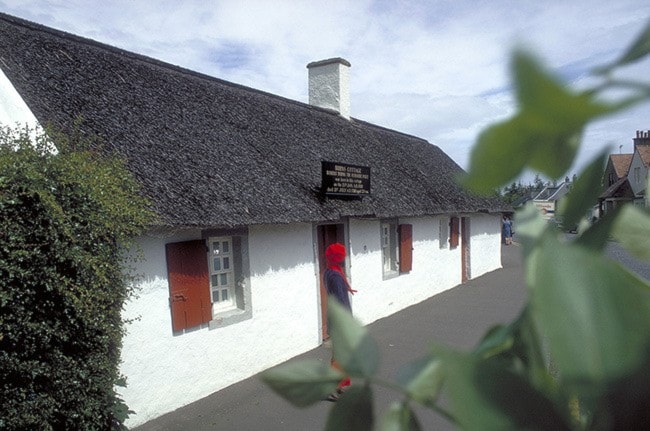On January 25, Scots worldwide charged their glasses (with well-aged Scotch whisky, of course) in this salute to Scotland’s National Poet:
Ladies and gentlemen! A toast! To the immortal memory of the Bard of Ayrshire – Robert Burns!
Born in Alloway, Ayrshire, on January 25, 1759, Burns wrote poetry and lyrics until his death in Dumfries following a tooth extraction on July 21, 1796. He was 37, married once and fathered 12 children, three of whom were illegitimate. Unusual for his time, he was a liberal who supported the French Revolution and the abolition of slavery, two very unpopular positions at the time which he wisely didn’t broadcast.
In 1801, five years after his death, friends held the first Burns Supper at Burns Cottage to celebrate his birth and to honour his literary works. As is customary today, guests would be welcomed, and the Burns (or Selkirk) Grace recited:
Some hae meat and canna eat,
And some wad eat that want it,
But we hae meat and we can eat,
And sae the Lord be thankit.
Following the soup course, the haggis would be ceremoniously paraded in and the ‘Address to a Haggis’ dramatically recited. The meal would end with the now familiar, Auld Lang Syne, written by Burns to celebrate Hogmanay (Dec. 31):
And there’s a hand, my trusty fiere!
And gie’s a hand o’ thine!
And we’ll tak’ a right guid-willie waught,
For auld lang syne.
As an Ayrshire-born lass, I was taught to respect Scottish history early by both my mother and grandmother. Father, who was born in Maybole, about seven miles from what is now Burns Birthplace Museum, took it more for granted.
Walking through the whitewashed cottage at the age of 11, I remember thinking it seemed small and unassuming to be so revered by the adults. Nonetheless, even I understood a sense of history prevailed.
The nearby Brig o’ Doon had a different impact. Here was the 15th century bridge where Tam o’ Shanter raced across on his trusty steed in the dead of night pursued by the dreaded Alloway Kirkyard witches and warlocks. Of course, as you know, such dreaded creatures are unable to cross running water, so all ended well. Burns crafted the dramatic tale in 1790.
The Ayrshire coast is dramatic. Wild and rugged, it is perfectly suited to profile one of my favourite cliff-top castles – Culzean.
Established by Clan Kennedy (of Robert the Bruce lineage) as a 16th century stone tower house, it evolved down the centuries into an impressive cliff-side castle.
Featured on the Scottish five pound note, Culzean’s dramatic drum tower sea view is one I’ve never forgotten. Sea caves under the castle were open to visitors when I was child, but these will be seasonal, so check in advance if they interest you.
[Lochranza Castle. Robert the Bruce is reputed to have landed on Arran during his battle to reclaim the Scottish throne. Photo: Ursula Maxwell-Lewis]
And, what’s a good castle without a few remaining spectres? A piper, servant girl, and at least five other ghosts are reputed to haunt the castle. That’s a Celtic holiday yarn you don’t get to blog about everyday.
In order to avoid estate taxes, Culzean was passed to the National Trust in 1945. Part of the Kennedy family deal was that the top floor be converted into an apartment for General Eisenhower as a gesture of appreciation for America’s support during the Second World War. Ike stayed there four times, and you certainly can, too. The rooms have since been converted into a country house hotel.
Glasgow day trip tour buses will ferry you around the Burns Country, the Ayrshire coast, and Culzean Castle for about £35.
Further along the coast are the expansive Saltcoats and Ardrossan beaches my cousins and I built sandcastles on as children. In the distance, only a ferry-ride away, is the Isle of Arran, the largest island in the Firth of Clyde. For me, this is an ancient isle of magic, memories, and wild beauty.
Evidence that it has been inhabited since at least the Stone Age can be found on the island. Arran claims a complex history of Gaels, Vikings, Celts, English, and was once ruled by Ireland. In Lamlash you’ll see a tribute to families who fled to North America during the Highland Clearances in the 1800s, and further on around the quiet island roads you’ll find the small, but charming, Brodick Castle.
[Low tide between Saltcoats and Ardrossan reveal a sweeping sandy playground. Photo: Ursula Maxwell-Lewis]
The one thing I missed on my last trip was the Isle of Arran Whisky Distillery in Lochranza. How did that happen! Perhaps the spirits were luring me back to explore more of Scotland’s romantic coasts. If so, I’m perfectly willing to indulge.
For more: see VisitScotland.com
– Ursula Maxwell-Lewis is a B.C.-based journalist and photographer
